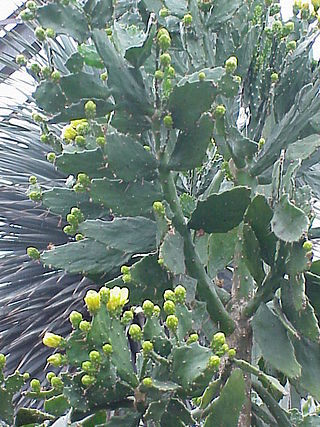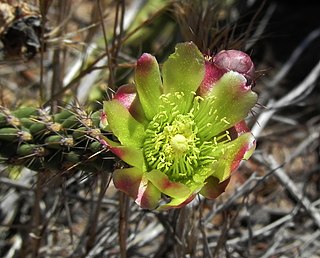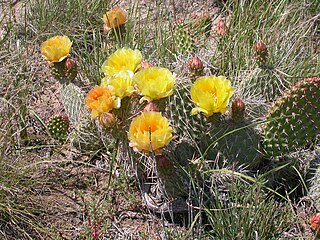
A cactus is a member of the plant family Cactaceae, a family comprising about 127 genera with some 1,750 known species of the order Caryophyllales. The word cactus derives, through Latin, from the Ancient Greek word κάκτος (káktos), a name originally used by Theophrastus for a spiny plant whose identity is now not certain. Cacti occur in a wide range of shapes and sizes. They are native to the Americas, ranging from Patagonia in the south to parts of western Canada in the north, with the exception of Rhipsalis baccifera, which is also found in Africa and Sri Lanka. Cacti are adapted to live in very dry environments, including the Atacama Desert, one of the driest places on Earth. Because of this, cacti show many adaptations to conserve water. For example, almost all cacti are succulents, meaning they have thickened, fleshy parts adapted to store water. Unlike many other succulents, the stem is the only part of most cacti where this vital process takes place. Most species of cacti have lost true leaves, retaining only spines, which are highly modified leaves. As well as defending against herbivores, spines help prevent water loss by reducing air flow close to the cactus and providing some shade. In the absence of true leaves, cacti's enlarged stems carry out photosynthesis.

Opuntia ficus-indica, the Indian fig opuntia, fig opuntia, or prickly pear, is a species of cactus that has long been a domesticated crop plant grown in agricultural economies throughout arid and semiarid parts of the world. O. ficus-indica is the most widespread and most commercially important cactus. It is grown primarily as a fruit crop, and also for the vegetable nopales and other uses. Cacti are good crops for dry areas because they efficiently convert water into biomass. O. ficus-indica, as the most widespread of the long-domesticated cactuses, is as economically important as maize and blue agave in Mexico. Opuntia species hybridize easily, but the wild origin of O. ficus-indica is likely to have been in central Mexico, where its closest genetic relatives are found.

Brasiliopuntia is a genus in the cactus family, Cactaceae. It contains only one species, Brasiliopuntia brasiliensis.

Echinocereus engelmannii, the strawberry hedgehog cactus or Engelmann's hedgehog cactus, is a cactus commonly found in desert areas of the southwestern United States and the adjacent areas of Mexico, including the states of California, Nevada, Utah, Arizona, Baja California and Sonora.

Opuntia engelmannii is a prickly pear common across the south-central and Southwestern United States and northern Mexico. It goes by a variety of common names, including desert prickly pear, discus prickly pear, Engelmann's prickly pear in the US, and nopal, abrojo, joconostle, and vela de coyote in Mexico.

Opuntia phaeacantha is a species of prickly pear cactus known by the common names brown-spine prickly pear, tulip prickly pear, and desert prickly pear found across the southwestern United States, lower Great Plains, and northern Mexico. The plant forms dense but localized thickets. Several varieties of this particular species occur, and it may hybridize with other prickly pears, making identification sometimes tricky.

Opuntia basilaris, the beavertail cactus or beavertail pricklypear, is a cactus species found in the southwest United States. It occurs mostly in the Mojave, Anza-Borrego, and Colorado Deserts, as well as in the Colorado Plateau and northwest Mexico. It is also found throughout the Grand Canyon and Colorado River region as well as into southern Utah and Nevada, and in the western Arizona regions along the Lower Colorado River Valley.

Opuntia humifusa, commonly known as the devil's-tongue, eastern prickly pear or Indian fig, is a cactus of the genus Opuntia present in parts of the eastern United States, Mississippi and northeastern Mexico.

Opuntia fragilis, known by the common names brittle pricklypear and little prickly pear, is a prickly pear cactus native to much of western North America as well as some midwestern states such as Illinois, Iowa, Wisconsin and Michigan. It also occurs in several Canadian provinces. It is known from farther north than any other cactus, occurring at as far as 56°N latitude in British Columbia. There is an isolated and possibly genetically unique population in Eastern Ontario known as the "Kaladar population".

Opuntia, commonly called the prickly pear cactus, is a genus of flowering plants in the cactus family Cactaceae, many known for their flavorful fruit and showy flowers. Prickly pear alone is more commonly used to refer exclusively to the fruit, but may also be used for the plant itself; in addition, other names given to the plant and its specific parts include tuna (fruit), sabra, nopal from the Nahuatl word nōpalli, nostle (fruit) from the Nahuatl word nōchtli, and paddle cactus. The genus is named for the Ancient Greek city of Opus, where, according to Theophrastus, an edible plant grew and could be propagated by rooting its leaves. The most common culinary species is the Indian fig opuntia (O. ficus-indica).

Opuntia robusta, the wheel cactus, nopal tapon, or camuesa, is a species of cactus in the family Cactaceae. It is native and endemic to central and northern Mexico to within 100 miles (160 km) of the Arizona and New Mexico borders where it grow from 5,000 to 10,000 feet on rocky slopes, open shrub lands, woodlands and mixed with other cactus and succulents.

Cylindropuntia echinocarpa is a species of cactus known by the common names silver cholla, golden cholla, and Wiggins' cholla. It was formerly named Opuntia echinocarpa.

Cylindropuntia californica is a species of cholla cactus known by the common name snake cholla. It is primarily found in Baja California, Mexico and the southernmost part of California in the United States. It is characterized by a short, decumbent habit, yellow-green flowers, elongated stems, and short spines. It is mostly found in coastal sage scrub and coastal chaparral habitats, but two varieties in Baja California can be found in foothills and deserts. In California, variety californica is regarded as a rare and threatened plant, with a California Native Plant Society listing of 1B.1, in part due to its limited number of occurrences and threats from development. It formerly was considered to have a larger range due to the inclusion of Cylindropuntia bernardina within it as the variety parkeri.

Opuntia aciculata, also called Chenille pricklypear, old man's whiskers, and cowboy's red whiskers, is a perennial dicot and an attractive ornamental cactus native to Texas. It belongs to the genus Opuntia. It is also widespread in Nuevo Leon and Tamaulipas.

Pediocactus bradyi is a very rare species of cactus known by the common names Brady's pincushion cactus, Brady's hedgehog cactus, and Marble Canyon cactus. It is endemic to Arizona in the US, where it is restricted to Marble Canyon in Coconino County, though its exact distribution is not generally advertised due to poaching concerns. It is limited to a specific type of soil, it has a small distribution, and the species is threatened by a number of human activities. This has been a federally listed endangered species of the United States since 1979.

Opuntia polyacantha is a common species of cactus known by the common names plains pricklypear, starvation pricklypear,. and hairspine cactus, panhandle pricklypear. It is native to North America, where it is widespread in Western Canada, the Great Plains, the central and Western United States, and Chihuahua in northern Mexico. In 2018, a disjunct population was discovered in the Thousand Islands region of Ontario, Canada.

Opuntia macrocentra, the long-spined purplish prickly pear or purple pricklypear, is a cactus found in the lower Southwestern United States and Northwestern Mexico. A member of the prickly pear genus, this species of Opuntia is most notable as one of a few cacti that produce a purple pigmentation in the stem. Other common names for this plant include black-spined pricklypear, long-spine prickly pear, purple pricklypear, and redeye prickly pear.

Opuntia trichophora is a species of cactus in the genus Opuntia, more commonly known as prickly pears or nopal. O. trichophora is distributed throughout parts of New Mexico, Colorado, and Utah, and may have disjoint populations in Wyoming, southern Montana, and southern Idaho. Opuntia trichophora is a diploid (2n=22) but has sometimes been treated as a variety of Opuntia polyacantha a tetraploid (2n=44). O. trichophora tends to have longer spines than O. polycantha or O. macrorhiza.

Opuntia erinacea, the Mojave prickly pear, variously treated as a species, or as a variety of Opuntia polyacantha, in the family Cactaceae, that is a distributed throughout the Mojave and into the southern Great Basin deserts.

Opuntia aurea is a cactus that grows in Southern Utah and perhaps Northern Arizona.




















